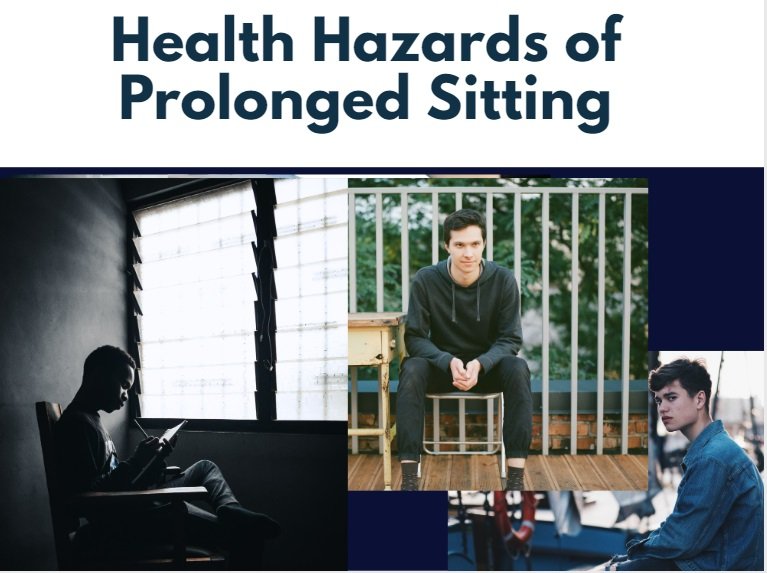Health Hazards of Prolonged Sitting
wellhealthorganic.com:health-hazards-of-prolonged-sitting is the URL of an article on the website wellhealthorganic.com. The article is titled “Health Hazards of Prolonged Sitting“.
According to the article, wellhealthorganic.com:health-hazards-of-prolonged-sitting can lead to many health problems, including:
- Increased risk of obesity, heart disease, and type 2 diabetes
- Muscle weakness and pain
- Poor circulation
- Varicose veins
- Deep vein thrombosis (DVT)
- Back pain
- Neck pain
- Headaches
- Eye strain
The article wellhealthorganic.com:health-hazards-of-prolonged-sitting also provides some tips for reducing the risks of prolonged sitting, such as:
- Getting up and moving around every 20-30 minutes
- Using a standing desk or treadmill desk
- Taking breaks throughout the day to stretch and walk
- Avoiding sitting in the same position for long periods
- Choosing a chair that is comfortable and supportive
If you are concerned about the health effects of prolonged sitting, it is important to talk to your doctor. They can help you determine your risk of developing health problems and recommend ways to reduce your risk.
Health Hazards of Prolonged Sitting with complete details
We often find ourselves spending prolonged hours sitting, be it at work, during commutes, or while unwinding in front of screens. However, the seemingly harmless act of sitting for extended periods comes with a set of health hazards that demand our attention and proactive measures.
Understanding Prolonged Sitting
Prolonged sitting, often defined as sitting for more than 8 hours a day, has become a norm for many. This sedentary lifestyle is perpetuated by various activities such as working at desks, binge-watching television, and excessive screen time.
Health Hazards Associated with Prolonged Sitting
The impact of prolonged sitting on health is multifaceted. From cardiovascular risks to musculoskeletal issues and a toll on mental well-being, the consequences are alarming. Studies indicate a direct correlation between extended sitting and increased mortality rates.
The Connection between Sitting and Chronic Conditions
The correlation between prolonged sitting and chronic conditions like obesity, diabetes, and certain types of cancers is well-established. Understanding this link is crucial for individuals aiming to mitigate the risks associated with a sedentary lifestyle.
Ergonomics and Sitting Posture
Maintaining an appropriate sitting posture is pivotal in preventing health issues related to prolonged sitting. Ergonomic workspaces can significantly contribute to a healthier sitting routine, minimizing strain on the body.
Breaks and Physical Activity
Incorporating regular breaks and engaging in physical activities are essential strategies to counteract the adverse effects of prolonged sitting. Even short walks or stretches during breaks can make a substantial difference in overall well-being.
Prolonged Sitting and Workplace Health
Employers play a crucial role in promoting a healthy work environment. Implementing strategies such as standing desks, encouraging breaks, and establishing employee wellness programs can contribute to a more active workplace.
Technology’s Role in Promoting Movement
The digital age offers solutions to combat sedentary behavior. Various apps and gadgets remind individuals to take breaks and engage in physical activities. Wearable technology further enhances awareness and encourages movement.
Tips for Individuals to Reduce Prolonged Sitting
Simple lifestyle changes, like taking the stairs instead of the elevator or opting for a standing desk, can go a long way in reducing sitting time. Creating a balance between work responsibilities and physical activity is key.
Standing Desks and Alternatives
Standing desks have gained popularity for their potential health benefits. Exploring alternatives to traditional sitting workstations, such as balance balls or kneeling chairs, provides additional options for those seeking a more active work setup.
Prolonged Sitting and Aging
The impact of sedentary behavior is amplified with age. Older adults are encouraged to stay active to maintain physical and mental well-being. Incorporating light exercises and regular movement is vital for healthy aging.
Educational Initiatives on the Hazards of Prolonged Sitting
Raising awareness about the hazards of prolonged sitting is crucial. Educational initiatives in schools and workplaces can empower individuals with the knowledge needed to make informed decisions about their daily activities.
Environmental Factors and Sedentary Lifestyles
Urban planning and the availability of recreational spaces influence physical activity levels. Designing environments that promote movement and provide access to outdoor activities can contribute to reducing sedentary lifestyles.
Prolonged Sitting in the Digital Age
The prevalence of screens in our lives has contributed to increased sedentary behavior. Balancing screen time with outdoor activities and adopting mindful tech usage can help mitigate the negative effects of prolonged sitting.
Conclusion
In conclusion, acknowledging the health hazards of prolonged sitting is the first step toward a more active and fulfilling life. By understanding the risks, implementing ergonomic practices, and incorporating regular physical activity, individuals can break free from the sedentary trap and embrace a healthier lifestyle.

FAQ
Is standing for long periods as harmful as prolonged sitting?
- While standing has its own set of challenges, prolonged sitting is associated with a higher risk of various health issues. It’s essential to find a balance and avoid extremes.
Can short breaks during work really make a difference?
- Yes, short breaks are effective in reducing the negative impact of prolonged sitting. They improve circulation, reduce muscle stiffness, and contribute to overall well-being.
Are standing desks suitable for everyone?
- Standing desks may not be suitable for individuals with certain health conditions. It’s advisable to consult with a healthcare professional before making significant changes to your workspace.
How can employers promote a more active workplace?
- Employers can promote a more active workplace by providing ergonomic furniture, encouraging regular breaks, and implementing wellness programs that focus on physical activity.
What role does technology play in combating sedentary behavior?
- Technology offers solutions, such as apps and wearable devices, to remind individuals to move and stay active. However, it’s essential to strike a balance and not solely rely on technology for a healthy lifestyle.



